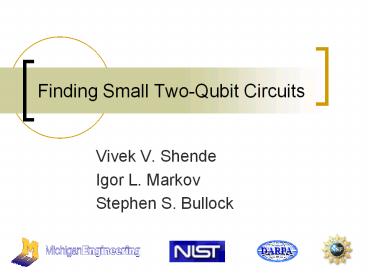Finding Small Two-Qubit Circuits - PowerPoint PPT Presentation
Title:
Finding Small Two-Qubit Circuits
Description:
DARPA DARPA Finding Small Two-Qubit Circuits Vivek V. Shende Igor L. Markov Stephen S. Bullock – PowerPoint PPT presentation
Number of Views:86
Avg rating:3.0/5.0
Title: Finding Small Two-Qubit Circuits
1
Finding Small Two-Qubit Circuits
- Vivek V. Shende
- Igor L. Markov
- Stephen S. Bullock
2
Outline
- Motivation
- Background
- One Qubit Rotations
- Two Qubit Entanglement
- Our Results
3
We Can Find
- A one-CNOT circuit to prepare a given 2-qubit
pure state from 0?. - A two-CNOT circuit to simulate a given 2-qubit
unitary operator up to relative phase. - A CNOT-optimal circuit, using at most three
CNOTs, to simulate a given 2-qubit unitary
operator.
4
We Can Find
- (If possible) A time, t, for a given Hamiltonian,
H, such that eiHt, is a CNOT, up to 1-qubit
gates. - We can also find the 1-qubit gates.
- An eighteen-CNOT circuit to simulate a given
three-qubit unitary operator. - (If a conjecture in Barenco et. Al. 95 holds)
5
1-Qubit Rotations
A. Barenco et al., Elementary Gates For Quantum
Computation, PRA 52, 1995.
- We use the following 1-qubit gates
- Any 1-qubit operator can be written as RzRyRz,
RxRzRx, RxRyRz, etc. - Three gates needed to simulate a generic operator
in SU(2), since dim SU(2) 3
6
2-Qubit Entanglement
S. Hill, K. Wooters, Entanglement of a Pair of
Quantum Bits, PRL 78, 1997.
- For a two-qubit state vector, f?, TFAE
- f? is not entangled, ie, f? f1?f0?
- ?0f? ?3f? - ?1f? ?2f? 0
- fTsy?2 f 0
- If u ? U(4) satisfies uTsy?2u sy?2
- (uf)Tsy?2 uf fTuTsy?2 uf fTsy?2f
- Thus u cannot introduce entanglement
- Hence is a wire swap followed by local unitaries
- u (a ? b)(wire swap), then det(a ? b) 1
- If det(u) 1, then u a ? b for a,b ? SU(2)
7
The Magic Basis
S. Hill, K. Wooters, Entanglement of a Pair of
Quantum Bits, PRL 78, 1997.
- EET sy?2 iff E-1SU(2)?2E SO(4)
- Proof
- u ? SU(2) iff uTsy?2u sy?2
- Equivalently, (E-1uE)T(E-1uE) 1
- Hence u ? SU(2) iff E-1uE ? SO(4)
- And such E ? U(4) exist
8
The Makhlin Invariants
Yu. Makhlin, Nonlocal Properties of Two-qubit
Gates and Mixed States and Optimization of
Quantum Computations, QIP 1, p. 243, 2002.
- For u,v ? SU(4), sy?2uTsy?2u and sy?2vTsy?2v have
the same spectra iff there exist a,b,c,d ?SU(2)
s.t. - Proof
- In the Magic Basis, this says that UUT is similar
to VVT iff there exist A,B ? SO(4) such that U
AVB - Write UUT A-1VVTA. Since UUT, VVT are
symmetric, can choose A ? SO(4). - Then U-1A-1V is in SO(4) and AU(U-1A-1V) V.
9
How many gates does it take
- to simulate a generic 2-qubit operator (up to
global phase)?
10
18 Gates Suffice
- Any 2-qubit operator can be simulated by a
circuit of the form - Proof Compute invariants
11
18 Gates Are Necessary
- Need 15 of the 1-parameter gates since SU(4) is
15-dimensional - Need 3 CNOTs to prevent cancellation
a
c
Rx
Rx
Ry
Rz
Ry
Rz
b
d
12
How many CNOTs does it take
- to simulate a given
- two-qubit operator?
13
How to count CNOTs
- For u in SU(4), let ?(u) uTsy?2usy?2
- Then u can be simulated using
- 1-qubit gates at most three CNOTs
- 1-qubit gates two CNOTs iff tr?(u) is real
- 1-qubit gates one CNOT iff ?(u)? ?i, ?(u)2 -1
- 1-qubit gates and a wire swap iff ?(u) ?i
- Only 1-qubit gates iff ?(u) ?1
- Proof Compute invariants
14
Examples
- Any u in SO(4) can be simulated by two CNOTs and
some 1-qubit gates - The wire swap needs three CNOTs
- The two-qubit QFT needs at least three CNOTs and
three 1-qubit gates
15
How many CNOTs does it take
- to simulate a given two-qubit operator up to
relative phase?
16
Simulation up to Relative Phase
- Two CNOTs are sufficient
- Proof for any u ? SU(4), can find a diagonal d
such that tr?(du) is real. - Useful because measurement in the computational
basis kills relative phase
17
Can I Simulate the CNOT
- by appropriately timing a given Hamiltonian?
18
Simulating CNOT
- Given a Hamiltonian, H, want to determine a time,
t, for which eiHt differs from CNOT by 1-qubit
gates - Compute ?(eiHt) for various values of t
19
Application CNOT in the presence of noise
- Fact can time H sx?sx to implement up to CNOT
1-qubit gates - Add a noise term, eg., (0.42) I?sz
- Numerical tests yield t0.80587
20
Conclusions
- We can find small (often optimal) circuits for
2-qubit operators
21
The End
22
Useful fact about sy































